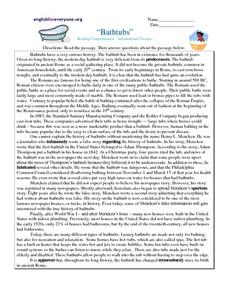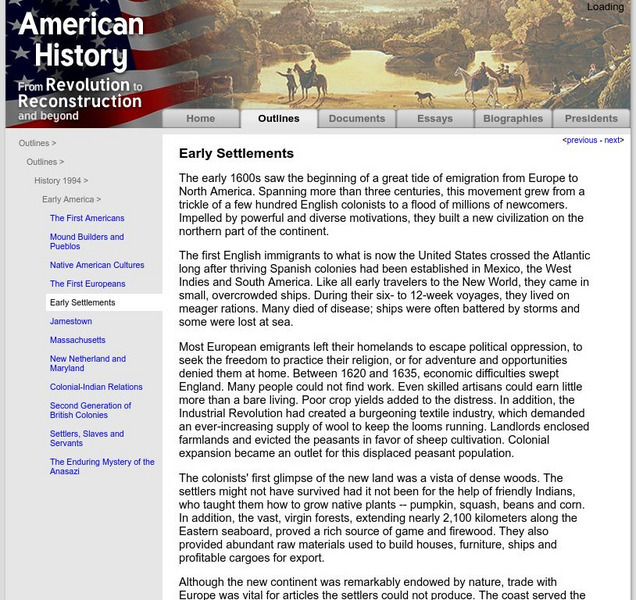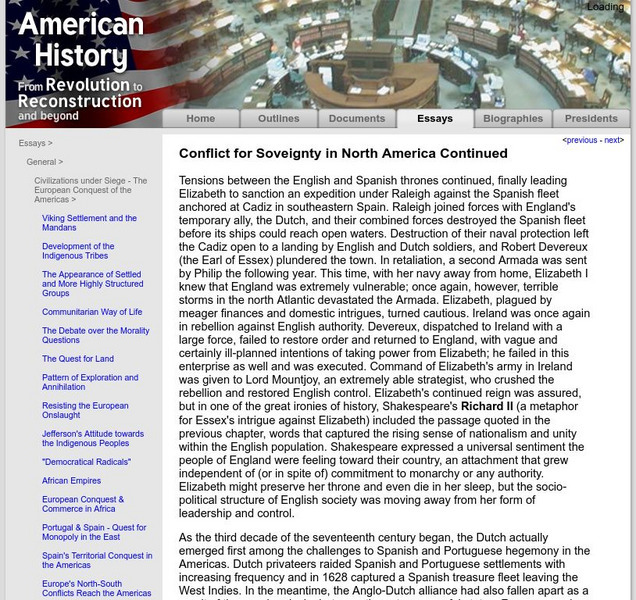Curated OER
Bathtubs
In this reading comprehension activity, students read the passage titled Bathtubs. They then answer the 12 questions pertaining to the passage.
Alabama Learning Exchange
Alex: The Early Americas Civilizations Power Point
This lesson is for cooperative learning groups. This lesson will take place in the classroom and the computer lab. Students will create PowerPoints on the early Americas civilizations of the Hohokam, Anasazi, Mississippians, Inuit,...
Other
Ancient American Civilizations: Mesoamerica
This resource gives an overview of the beginnings of Mesoamerican civilization. The sections about the Olmec are "Early Preclassic" and "Middle Preclassic." Includes information about the raw materials and the luxury items used by the...
BBC
Bbc: The Lost Pyramids of Caral
A transcript of a TV documentary about the ancient American civilization found in Caral, Peru. The show features interviews with all three members of the original archaeological team that dated Caral to 2600 B.C. There is a nice...
University of Groningen
American History: Outlines: Early Settlements
The early 1600s saw the beginning of a great tide of emigration from Europe to North America. Spanning more than three centuries, this movement grew from a trickle of a few hundred English colonists to a flood of millions of newcomers....
Northern Illinois University
N. Illinois Univ.: Piramide Mayor
A nice graphic on the major temple structure found at Caral, Peru, the location of the oldest civilization in the Americas.
Smithsonian Institution
Smithsonian Magazine: First City in the New World?
An account about Caral, Peru that suggests there was a civilization present in Peru much earlier than was previously thought. The article describes Caral as an ancient city that was flourishing at the same time the Great Pyramids were...
Other
Archaeological Legacy Institute: Caral: Oldest City in the New World
An interview with one of the principal archaeologists (Ruth Shady) involved in the dig at Caral, Peru, site of the oldest civilization in South America. The interview is available in English or in Spanish in mp3 format.
University of Groningen
American History: Outlines: Early Settlements
The early 1600s saw the beginning of a great tide of emigration from Europe to North America. Spanning more than three centuries, this movement grew from a trickle of a few hundred English colonists to a flood of millions of newcomers....
University of Groningen
American History: Essays: Development of the Indigenous Tribes
Essay on the development of early indigenous tribes in the Americas. Author discusses how tribal culture developed in South America prior to Columbus.
Other
Simon Frasier University: A Journey to a New Land
This interactive site examines questions about early human migration to North America offers grade-level appropriate information for primary, elementary, middle, secondary and post-secondary levels. Teacher resources, simulations, video,...
University of Groningen
American History: Essays: Europe's North South Conflicts Reach the Americas
An essay detailing early English and French exploration and settlement in the New World to challenge Spanish control.
Archaeological Institute of America
Archaeology Archive: A Monumental Feud by Roger Atwood
An article describing the oldest city found in the Americas: Caral, Peru. The author gives details on how there is a disagreement between members of the original team of archaeologists who dated the site in 2001. This has led to two...
University of Groningen
American History: Essays: Conflict for Sovereignty in N. Amer. Continued
Essay outlines the continued tension between England, Spain and other European nations in their quest for power. The British claim sovereignty over North America.
University of Groningen
American History: Essays: Viking Settlement and the Mandans
Essay investigating the migration and settlement of Eurasion tribal groups across the Atlantic ocean to North America.
Discovery Education
Discovery Education: Rome's Rise to Power: The Republic
A detailed lesson plan designed to teach students about the republican form of government established by the Romans in their early history and also how it relates to American government today.















